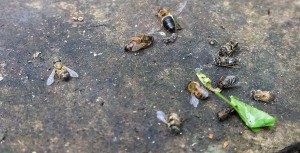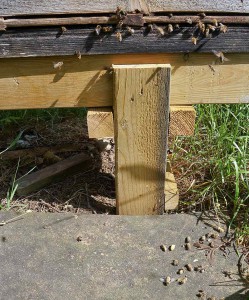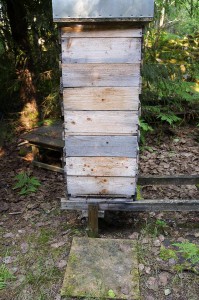One of the most important parts in my management system has become a simple thin hardboard in front of the entrance. The first thing I do when I come to an apiary is going reading them. They give a lot of info, important for eventual actions.
If the hardboard is empty of dead bees, litter etc – it’s the best. Very often you find a few dead worker bees there. It seems this is of no concern.
If you find a dead queen there, the old one or a virgin, you know the hive is shifting its queen, with or without swarming. Even if the colony has had no problems with mites or viruses for a short time with the last of capped brood, you can find a few wingless bees. It seems in such a circumstance it’s of no big concern. But be careful and watch the colony carefully for eventual thymol treatment.
 A dead queen! Drones, some workers and one old worker pupa (to the right).
A dead queen! Drones, some workers and one old worker pupa (to the right).
If you find a lot of dead bees. Even without wingless bees among them, I consider it to be showing the bees are fighting something. Maybe another virus than DWV.
If the colony has a lot of drones maybe due to a lot drone comb, they might start throwing them out in the middle of the season, or at least some of them. I’m not sure sometimes how to interpret this. Sometimes it seems the colony has shifted its queen and now it’s laying and the bees have no need for many drones.
When you see white parts or whole drone pupae, the bees most probably are fighting varroa, throwing out pupae with mites. And this is a very good sign actually. Varroa mites should be a drone parasite and not a workerbee parasite. And the bees should identify them in drone brood and clean those cells with mites (that have reproducedand and have offspring) – VSH in drone brood, or just cleaning out drone brood with mites.
 Drone pupae, quite some. This colony hasn’t needed any thymol, yet anyway. And given a good crop.
Drone pupae, quite some. This colony hasn’t needed any thymol, yet anyway. And given a good crop.
The next step that I usually see among my bees after seeing drone pupae on the hardboard is seeing wingless drones there. No big concern at this stage. If the reinvasion is big, if there are some colonies not fighting the mite very well they will spread many mites to other colonies. For some colonies that may mean they will need help in fighting the mites.
Next step among my bees may be seeing young grey bees walking on the hardboard, but with ok wings. Maybe another virus than DWV. And the next step wingless bees, one or two to begin with.
Now the colony gets one or two pieces of dishcloth with thymol (5 grams each), but not immediately before harvesting honey. I take away honey first. If there will be more than 14 days to harvesting they get thymol. It’s more important to have healthy bees that pollinate well, than some more thymol in the honey you can’t taste and is of no problem for health for anyone – and a dying colony. I know out of experience.
The breeder queens have not tasted any thymol for at least one year. My stock is making progress.

as the more experienced beekeepers always say , you can tell a lot from reading the board. I have a few pieces of old polycarbonate which I cut into pieces and place in front of the hive too, since our weather is quite warm whole year round I use screen bottom with removable board which gives us a lot of clues too what’s happening inside. I found some swarm cells last weekend and promptly moved them to a nuc. Just this morning upon pulling out the bottom board found a lot of wax bits sensing something wrong I bent down, peeked and found a lot of dead bees , they must’ve been robbed hard, I reduced the entrance and hopefully if the rain stops open it up and see what can be done to help them. Boards give us a lot of info 🙁
Very useful comment for me! I will copy this and putting hardboard in front of my hives too….:-)